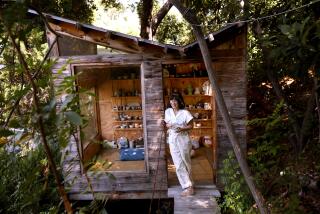The Art of Tea : The Search for the Right Lid, and Other Predicaments of Teapot Collecting
- Share via
Of all the ungraceful things made by man--the objects that no amount of streamlined design or fancy ornament can redeem--the teapot heads the list. You can’t get away from it: The teapot, almost by definition, must have a spout, a handle and a lid. All three of these necessary excrescences militate against unity of design, ‘truth to material’ and all the other qualities that are supposed to make an artifact beautiful.
Yet, beautiful teapots have been made. Among the first made in Europe were the red pottery teapots produced by Johann Bottger at the Meissen (Dresden) factory in Germany during the early 18th Century. Bottger had been an alchemist, and when the Elector Augustus of Saxony decreed that he should instead try to discover the secret of Chinese porcelain, a disgruntled Bottger posted above the door of his workroom this sarcastic rhyme:
Gott, unser Schoepfer, hat gemacht aus einem Goldmacher einen Toepfer.
(God, our creator, has turned a gold maker into a potter.)
Bottger’s teapots have an agreeable, uncluttered form. They look as if they were made of iron-red lipstick, but the material earned its trade name of “stoneware”: It was hard enough to be cut on a lapidary’s wheel. Like most early teapots, they are surprisingly tiny to the modern eye. Tea was still a rare and valuable commodity. It was sipped from small tea-bowls, not from cups with handles.
In England, tea-drinking was first made fashionable by Charles II’s queen in the late 17th Century, but the habit spread quickly. As tea drinking became more popular, teapots became larger, and European factories vied with each other in making alternatives to imported Chinese wares. Before the American Revolution, Chinese porcelain for America, such as the teacups from which William Penn is supposed to have drunk oolong tea when he visited some of the wealthy Friends of Philadelphia in the late 17th Century, had to be taken to England before being shipped to America, because of the East India Co.’s monopoly. The first serious attempt to manufacture porcelain in the United States was made by Andrew Duche in Savannah, Ga., in the 1730s. The earliest American porcelain in existence was made by Bonnin & Morris in Southwark, Pa., between 1769 and 1772. Workers were brought over from England, and a lottery was held to finance the business. Benjamin Franklin was a client of the factory, and Sir William Johnson of Albany, superintendent of Indian affairs, bought a whole breakfast service, which presumably included a teapot.
In the English pottery industry, the late 18th Century was the period of neoclassicism and the Industrial Revolution; and Josiah Wedgwood was the greatest promoter of both in the ceramics industry. His blue-and-white “jasper” wares are the best known, but he also made black “basalt” wares. An old Punch magazine cartoon shows the chatelaine of a stately British home pointing to the tea table and saying to her husband: “The black Wedgwood teapot! Someone in (the) cook’s family must have died.”
The first teapot I bought that showed me the full potential of the teapot as an art form was of black basalt. It was made by Elijah Mayer, one of Wedgwood’s Staffordshire imitators. I spotted it in the window of a Dublin antique shop run by a wonderful old man named William Delany. He was full of anecdotes; for example: “You see that engraving of Lord Nelson in the window? The other day a gentleman came in, he was the spit and image of that engraving; and who d’ye think he was? The present Lord Nelson! “
The black basalt teapot was made to commemorate another hero, the Duke of Wellington. It had a lion as a spout and a coiled serpent as its handle. On one side was a bust of Wellington being crowned with laurels by a draped woman. The whole thing sounds preposterous; yet it worked. The parts added together in a satisfying whole, a dramatic unity.
The two teapots illustrated also belong to the later phase of neoclassicism, the English Regency period. They date from about 1810 to 1820. They are much more demure than the Wellington teapot and would fit into the setting of a Jane Austen novel. I bought the black-and-white pot in an English antique shop for about $80. It shows a goddess being hauled through the air by birds, and a god in a turtle-shell chariot being pulled by rams. It was probably made at the New Hall, Staffordshire, factory. The other teapot cost me $3 in a Los Angeles garage sale two years ago. The spout is badly chipped, which greatly reduces the value, but it was still a bargain. Miraculously, the lid is in perfect condition. So what I am looking for now is an undamaged teapot of the same attractive pattern, with a broken lid.
More to Read
Eat your way across L.A.
Get our weekly Tasting Notes newsletter for reviews, news and more.
You may occasionally receive promotional content from the Los Angeles Times.










